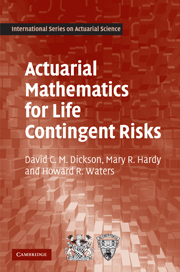Book contents
- Frontmatter
- Contents
- Preface
- 1 Introduction to life insurance
- 2 Survival models
- 3 Life tables and selection
- 4 Insurance benefits
- 5 Annuities
- 6 Premium calculation
- 7 Policy values
- 8 Multiple state models
- 9 Pension mathematics
- 10 Interest rate risk
- 11 Emerging costs for traditional life insurance
- 12 Emerging costs for equity-linked insurance
- 13 Option pricing
- 14 Embedded options
- A Probability theory
- B Numerical techniques
- C Simulation
- References
- Author index
- Index
6 - Premium calculation
- Frontmatter
- Contents
- Preface
- 1 Introduction to life insurance
- 2 Survival models
- 3 Life tables and selection
- 4 Insurance benefits
- 5 Annuities
- 6 Premium calculation
- 7 Policy values
- 8 Multiple state models
- 9 Pension mathematics
- 10 Interest rate risk
- 11 Emerging costs for traditional life insurance
- 12 Emerging costs for equity-linked insurance
- 13 Option pricing
- 14 Embedded options
- A Probability theory
- B Numerical techniques
- C Simulation
- References
- Author index
- Index
Summary
Summary
In this chapter we discuss principles of premium calculation for insurance policies and annuities. We start by reviewing what we mean by the terms ‘premium’, ‘net premium’ and ‘gross premium’. We next introduce the present value of future loss random variable. We define the equivalence premium principle and we show how this premium principle can be applied to calculate premiums for different types of policy. We look at how we can use the future loss random variable to determine when a contract moves from loss to profit or vice versa. We introduce a different premium principle, the portfolio percentile premium principle, and show how, using the mean and variance of the future loss random variable, the portfolio percentile premium principle can be used to determine a premium. The chapter concludes with a discussion of how a premium can be calculated when the insured life is subject to some extra level of risk.
Preliminaries
An insurance policy is a financial agreement between the insurance company and the policyholder. The insurance company agrees to pay some benefits, for example a sum insured on the death of the policyholder within the term of a term insurance, and the policyholder agrees to pay premiums to the insurance company to secure these benefits. The premiums will also need to reimburse the insurance company for the expenses associated with the policy.
- Type
- Chapter
- Information
- Actuarial Mathematics for Life Contingent Risks , pp. 142 - 175Publisher: Cambridge University PressPrint publication year: 2009



